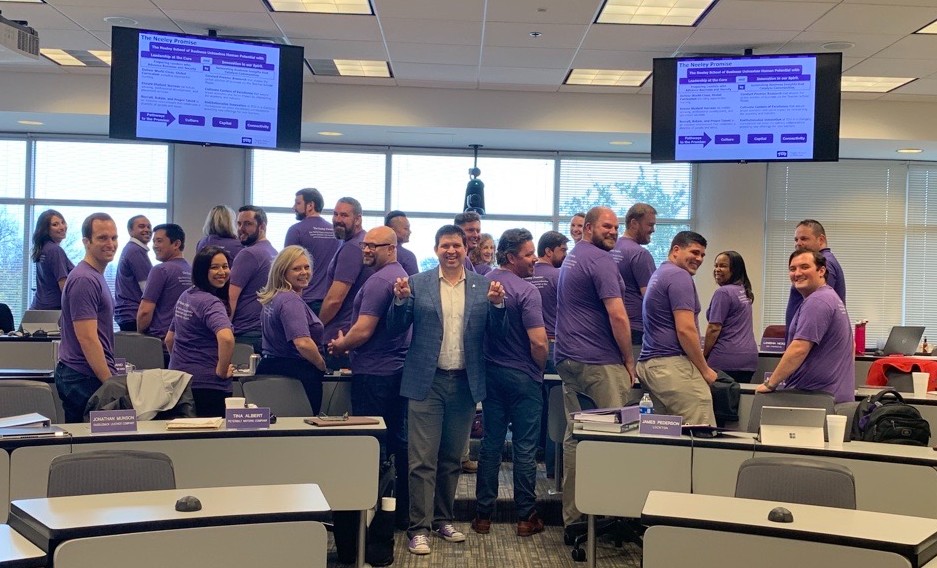There’s a premium on highly skilled professionals – especially on those capable of innovating change. Even during a pandemic, the most talented candidates have options, and unless your organization is on the forefront, those candidates are going to choose another organization.
October 26, 2020
There’s a premium on highly skilled professionals – especially on those capable of innovating change. Even during a pandemic, the most talented candidates have options, and unless your organization is on the forefront, those candidates are going to choose another organization.

Dean Daniel Pullin teaches innovation at the TCU Neeley School of Business, and in the October 2020 EMBA preview webinar, he shared how to apply innovation principles to the challenge of attracting and retaining great talent. Check out his top five focus points.
- Purpose. It’s about more than just the bottom line. You need more than a competitive salary to attract Millennial and Gen Z talent. They are thinking about the amount of time they are going to invest in their work, on a daily basis as well throughout their lives, and they want to know they’re doing something that makes a difference for humanity. Attracting these candidates may mean changing something about the way you do business (e.g. finding ways to go green) or it may simply mean reframing the way you talk about your mission, products or services, focusing more on how you benefit customers and the community.
- Flexibility. Look for ways you can allow personalization in the way your employees work. Even before the pandemic, many leading companies were taking a long look toward telecommuting, and the pandemic has afforded us all a grand experiment in this area. It may be time to consider whether you even need the overhead of a physical building. But be sure to consider ways individual employees can customize the work environment to their needs. Some people may work better from home; some may still want an office that allows them to focus on work away from the distractions of home.
- Digitization. This should be a core competency of your entire organization; not just the IT department. It should be in HR, the C-suite, marketing and beyond. What new technology can improve productivity? How can you streamline communication with your team or reach your customers where they are? Think about it both internally (e.g. project management software, digital onboarding) and externally (a stronger social media presence, a chat function on your website).
- Inclusive excellence. Cultural competency is increasingly important, especially as the country’s demographic changes and the global supply chain is more and more connected. That doesn’t only mean awareness and understanding of the diversity of ethnicities or sexes, but also including a diversity of backgrounds, viewpoints and ideas when facing challenges or opportunities. The more viewpoints you include, the better chances you have of finding the right solution for any given challenge. The more diverse team, the better you will be able to relate to an increasingly diverse customer base. Any good candidate will need to be a culturally competent leader, and to attract those candidates, it will take an organization that embraces inclusion as the path to excellence.
- Transparency. Think about how you represent your company online, on social media, with influencers and on sites such as Glassdoor and Indeed. Know how that message will be interpreted by Gen Z and Millennials. These generations want the straight scoop. They value authenticity and the unvarnished truth about your purpose, about what they are signing up for, about what you value in an employee and what you don’t. Transparency, even about the parts of the job that seem less than attractive, will lend you a lot of credibility with this workforce.
An important note about Gen Z vs. Millennials
Both Gen Z and Millennials value purpose and are looking for meaningful work, but Gen Z is a little different. Their lives have been bookended by two major economic crises, between the 2008-2009 recession and the 2020 pandemic. Many have seen their parents laid off; many have seen some of their own job opportunities vanish. This makes Gen Z more risk averse than Millennials. They will be looking for those salary and benefits packages, and may be willing to adjust to different working circumstances if they feel the organization offers more certainty for their career. That’s another instance when transparency can help you.
Long- and short-term priorities
While your short-term priority for the pandemic may be stabilizing your organization and making some tough decisions to maintain viability, your next priority should be a strategy for long term success, and that’s going to include both innovation and great talent; key components that work hand in hand to carry your organization well into the future.
Liked this? Attend our next webinar for more insights from an EMBA faculty member, and a chance to ask questions of current students and alumni.

